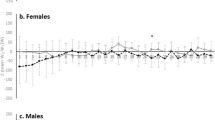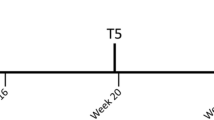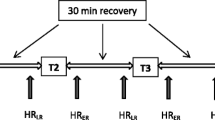Abstract
Few data exist examining the body composition, endocrine, and anaerobic exercise performance changes over a competitive wrestling season. Eighteen NCAA wrestlers were tested for endocrine markers, body composition, hydration, grip strength, and power on four occasions: prior to pre-season training (T1); after pre-season training 3 days prior to the first seasonal meet (T2); mid-season one day prior to a meet (T3); and at the end of the season 2–3 days following the last meet (T4). Body mass, percent body fat (BF %), and fat mass were significantly lower (P ≤ 0.05) at T2 and T3 compared to T1 but were not different between T1 and T4. Lean body mass was significantly reduced at T2 only. Urine specific gravity was significantly elevated at T3 compared to T1, T2, and T4. Resting cortisol concentrations did not change but resting testosterone concentrations were significantly reduced at T2, T3, and T4. Maximal grip strength was significantly reduced at T2. Vertical jump peak power was significantly reduced at T2, T3, and T4. Wingate peak power was significantly reduced at T2 and T3. However, Wingate average power and total work did not significantly change. Fatigue rate during the Wingate test was significantly improved at T2, T3, and T4 compared to T1. In conclusion, body mass, BF %, and measures of peak force and power were reduced for most of the competitive wrestling season. Competitive wrestling reduces resting total testosterone concentrations throughout the entire season.


Similar content being viewed by others
Abbreviations
- 1RM:
-
One repetition-maximum
- ANOVA:
-
Analysis of variance
- BF %:
-
Body fat percent
- BMI:
-
Body mass index
- CORT:
-
Cortisol
- ELISA:
-
Enzyme-linked immunosorbent assay
- HPL:
-
Human performance laboratory
- LBM:
-
Lean body mass
- NCAA:
-
National Collegiate Athletic Association
- T1–T4:
-
Time points 1 through 4
- TE:
-
Testosterone
- USG:
-
Urinary specific gravity
References
Barbas I, Fatouros IG, Douroudos II, Chatzinikolaou A, Michailidis Y, Draganidis D, Jamurtas AZ, Nikolaidis MG, Parotsidis C, Theodorou AA, Katrabasas I, Margonis K, Papassotiriou I, Taxildaris K (2011) Physiological and performance adaptations of elite Greco-Roman wrestlers during a one-day tournament. Eur J Appl Physiol 111:1421–1436
Bartok C, Scholler DA, Clark RR, Sullivan JC, Landry GL (2004a) The effect of dehydration on wrestling minimum weight assessment. Med Sci Sports Exerc 36:160–167
Bartok C, Schoeller DA, Sullivan JC, Clark RR, Landry GL (2004b) Hydration testing in collegiate wrestlers undergoing hypertonic dehydration. Med Sci Sports Exerc 36:510–517
Booth A, Mazur AC, Dabbs JM (1993) Endogenous testosterone and competition: the effect of “fasting”. Steroids 58:348–350
Buford TW, Rossi SJ, Smith DB, O’Brien MS, Pickering C (2006) The effects of a competitive wrestling season on body weight, hydration, and muscular performance in collegiate wrestlers. J Strength Cond Res 20:689–692
Dixon CB, Deitrick RW, Pierce JR, Cutrufello PT, Drapeau LL (2005) Evaluation of the BOD POD and leg-to-leg bioelectrical impedance analysis for estimating percent body fat in National Collegiate Athletic Association Division III collegiate wrestlers. J Strength Cond Res 19:85–91
Firrell JC, Crain GM (1996) Which setting of the dynamometer provides maximal grip strength? J Hand Surg 21:397–401
Fragala MS, Kraemer WJ, Denegar CR, Maresh CM, Mastro AM, Volek JS (2011) Neuroendocrine-immune interactions and responses to exercise. Sports Med 41:621–639
Fry AC, Schilling BK, Fleck SJ, Kraemer WJ (2011) Relationships between competitive wrestling success and neuroendocrines responses. J Strength Cond Res 25:40–45
HoLBMan JR, Ratamess NA, Kang J, Rashti SL, Faigenbaum AD (2009) Effect of Betaine supplementation on power performance and fatigue. J Int Soc Sports Nutr 6:1–10
Horswill CA (1992) Applied physiology of amateur wrestling. Sports Med 14:114–143
Jackson A, Pollock M (1978) Generalized equations for predicting body density of men. Br J Nutr 40:497–504
Karila TA, Sarkkinen P, Marttinen M, Seppala T, Mero A, Tallroth K (2008) Rapid weight loss decreases serum testosterone. Int J Sports Med 29:872–877
Kelly JM, Gorney BA, Kalm KK (1978) The effects of a collegiate wrestling season on body composition, cardiovascular fitness and muscular strength and endurance. Med Sci Sports 10:119–124
Klinzing JE, Karpowicz W (1986) The effects of rapid weight loss and rehydration on a wrestling performance test. J Sports Med 26:149–156
Kraemer WJ, Ratamess NA (2005) Hormonal responses and adaptations to resistance exercise and training. Sports Med 35:339–361
Kraemer WJ, Fry AC, Rubin MR, Triplett-McBride T, Gordon SE, Koziris LP, Lynch JM, Volek JS, Meuffels DE, Newton RU, Fleck SJ (2001) Physiological and performance responses to tournament wrestling. Med Sci Sports Exerc 33:1367–1378
Kuzala EA, Vargo MC (1992) The relationship between elbow position and grip strength. Am J Occup Ther 46:509–512
Lingor RJ, Olson A (2010) Fluid and diet patterns associated with weight cycling and changes in body composition assessed by continuous monitoring throughout a college wrestling season. J Strength Cond Res 24:1763–1772
Marttinen RHJ, Judelson DA, Wiersma LD, Coburn JW (2011) Effects of self-selected mass loss on performance and mood in collegiate wrestlers. J Strength Cond Res 25:1010–1015
NCAA: Memorandum: NCAA Wrestling Weight Management Program for 2010–2011, pp 1–34. 20 Aug 2010
Oppliger RA, Case HS, Horswill CA, Landry GL, Shelter AC (1996) American College of Sports Medicine position stand: Weight loss in wrestlers. Med Sci Sports Exerc 28:ix–xii
Passelerque P, Lac G (1999) Saliva cortisol, testosterone and T/C ratio variations during a wrestling competition and during the post-competitive recovery period. Int J Sports Med 20:109–113
Ratamess NA, Faigenbaum AD, Mangine GT, HoLBMan JR, Kang J (2007) Acute muscular strength assessment using free weight bars of different thickness. J Strength Cond Res 21:240–244
Roemmich JN, Sinning WE (1997a) Weight loss and wrestling training: effects on nutrition, growth, maturation, body composition, and strength. J Appl Physiol 82:1751–1759
Roemmich JN, Sinning WE (1997b) Weight loss and wrestling training: effects on growth-related hormones. J Appl Physiol 82:1760–1764
Schmidt WD, Piencikowski CL, Vandervest RE (2005) Effects of a competitive wrestling season on body composition, strength, and power in National Collegiate Athletic Association Division III college wrestlers. J Strength Cond Res 19:505–508
Serfass RC, Stull GA, Alexander JF, Ewing JL (1984) The effects of rapid weight loss and attempted rehydration on strength and endurance of the handgripping muscles in college wrestlers. Res Q Exerc Sport 55:46–52
Singer RN, Weiss SA (1968) Effects of weight reduction on selected anthropometric, physical, and performance measures of wrestlers. Res Q 39:361–369
Siri WE (1956) Gross composition of the body. In: Lawrence JH, Tobias CA (eds) Advances in biological and medical physics, IV. Academic Press, New York
Song TM, Cipriano K (1984) Effects of seasonal training on physical and physiological function on elite varsity wrestlers. J Sports Med 24:123–130
Strauss RH, Lanese RR, Malarkey WB (1985) Weight loss in amateur wrestlers and its effect on serum testosterone levels. JAMA 254:3337–3338
Utter AC (2001) The new National Collegiate Athletic Association wrestling weight certification program and sport-seasonal changes in body composition of college wrestlers. J Strength Cond Res 15:296–301
Utter AC, Stone M, O’Bryant H, Summinski R, Ward B (1998) Sport-seasonal changes in body composition, strength, and power of college wrestlers. J Strength Cond Res 12:266–271
Utter AC, Scott JR, Oppliger RA et al (2001) A comparison of leg-to-leg bioelectrical impedance and skinfolds in assessing body fat in collegiate wrestlers. J Strength Cond Res 15:157–160
Utter AC, O’Bryant HS, Haff GG, Trone GA (2002) Physiological profile of an elite freestyle wrestler preparing for competition: a case study. J Strength Cond Res 16:308–315
Webster S, Rutt R, Weltman A (1990) Physiological effects of a weight loss regimen practiced by college wrestlers. Med Sci Sports Exerc 22:229–234
Yankanich J, Kenny WL, Fleck SJ, Kraemer WJ (1998) Precompetition weight loss and changes in vascular fluid volume in NCAA Division I college wrestlers. J Strength Cond Res 12:138–145
Yard EE, Collins CL, Dick RW, Comstock RD (2008) An epidemiologic comparison of high school and college wrestling injuries. Am J Sports Med 36:57–64
Acknowledgments
We would like to thank all of the wrestlers and head coach David Icenhower for their support and participation in this study. We would also like to thank Gregory Osgoodby, Tyler Branham, and Daniel Dicolo for their assistance with testing and Disa Hatfield, Maren Fragala, Jen Yu-Ho, and Gwendolyn Thomas for their assistance with the hormonal analyses.
Conflict of interest
The authors declare that they have no conflict of interest.
Author information
Authors and Affiliations
Corresponding author
Additional information
Communicated by Fabio Fischetti.
Rights and permissions
About this article
Cite this article
Ratamess, N.A., Hoffman, J.R., Kraemer, W.J. et al. Effects of a competitive wrestling season on body composition, endocrine markers, and anaerobic exercise performance in NCAA collegiate wrestlers. Eur J Appl Physiol 113, 1157–1168 (2013). https://doi.org/10.1007/s00421-012-2520-8
Received:
Accepted:
Published:
Issue Date:
DOI: https://doi.org/10.1007/s00421-012-2520-8




